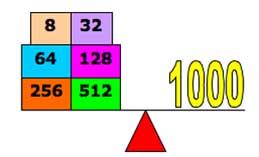Balance power
Problem
Image

|
You can weigh all integer masses from 1 to 60 with 6 weights
putting the weights in one pan and the object in the other pan.
Which weights are used?
What about weighing all integer masses from 1 to 1000 or from
1 to n?
How many weights are needed if you put weights in both
pans?
|
Getting Started
Try weights from 1 to 15 units. Can you spot a pattern? Can you explain it? Now continue the pattern.
You might find the following spreadsheet tool useful for the last part of the problem.
Student Solutions
There was a lot of interest and a big response to this problem. However finding an answer should prompt the questions: "Why does this happen?" , "Can I explain and prove it?", "Can the result be proved for ALL values of n?" This question remains a Tough Nut and the challenge is to prove that the method using both scale pans always works.
|
Image

Thank you to Phil of Garforth Community College for this diagram. |
This is a solution to the first part from Jeremy of Taunton
Prep School.
All numbers can be expressed in Base 2 (Binary) as a sum of
powers of 2, written using only the digits 1 or 0.
Objects of integer mass up to 60 (indeed up to 63, for 63 =
2^6 - 1), can all be balanced by combinations using a maximum of
one of each of the following weigths: 1, 2, 4, 8, 16 and 32
units.
Objects of integer mass up to 1000 units (in fact up to 1023
units) can all be balanced by combinations using a maximum of one
of each of 10 different weights, as
$2^9 < 1000 < 2^{10}.$
Therefore, the number of different weights (w) needed to weigh
up to n units is related to the number (n), by the
expression:
$2^{w-1} \leq n < 2^w$. |
Can you prove the following result which was spotted by Chanwc from Hong Kong and Utku Alhan from Robert College of Istanbul who realised that the number of weights is given by:
$w = [(log n)/(log 2)] + 1 $ where the square brackets $[\ ]$ means 'the integer part of' and the weights are $2^0, 2^1, ..., 2^{w-1}$.
It remains to prove that the folllowing method, described by Joris from Claremont High School, will always work for all n.
If it is possible to put weights on both sides, you only need to use powers of 3. The first weight is worth 1, the second worth 3. You can form 1 (1), 2 by putting 3 on one side and 1 on the other (3-1). The maximum weight you can form is 6 (1+2+3). Instead of taking 7, you only need a weight worth 9, so you can form 7 (9-2) and 8 (9-1). This goes further, and to form all integers between 1 and 60, you only need 5 weights, 1, 3, 9, 27, 81.Teachers' Resources
Why do this problem?
Learners can discover the base two number system for themselves and gain experience of working with powers of 2 and 3. The problem can be used to reinforce understanding of place value.
The generalisation to the problem which allows weights in both pans leads naturally to representing numbers in base 3.
Possible approach
As a class, work together through weighing 1, 2, 3, 4, 5 and 6 units with the fewest weights possible and then ask the learners to continue the process.
Key questions
Weights in one pan only
What weights are needed to weigh 1, 2, 3,....15 units?
What pattern do you notice in the weights used? Can you explain it?
When you include another weight in the set of weights used how many objects can now be weighed?
How many weights are needed to weigh objects of 1, 2, 3 ... 100 units?
How many weights are needed to weigh 1 to 1000 units or 1 to n units?
Weights in both pans
What weights are needed to weigh 1, 2, 3,....13 units?
What pattern do you notice in the weights used? Can you explain it?
When you include another weight in the set of weights used how many objects can now be weighed?
How many weights are needed to weigh objects of 1, 2, 3 ... 100 units?
How many weights are needed to weigh 1 to 1000 units or 1 to n units?
Possible extension
Discuss with the class the idea that, using both pans, the weights are used either as +1 times the weight (in the opposite pan to the object), 0 times the weight (not used at all), or -1 times the weight (in the same pan as the object). We are using a numbering system
$$a_0 + a_1x + a_2x^2 + a_3x^3 + ...$$ where the coefficients $a_0, a_1$ etc. are all 1, 0 or -1 and $x=3$. By a (reversible) 'shift' this is changed to the base 3 number system.
All integers can be written in base 3 with digits 0, 1 and 2, that is as $$b_0 + b_1x + b_2x^2 + b_3x^3 + ...$$ where the coefficients $b_0, b_1$ etc. are all 0, 1 or 2 and $x=3$. This explains why all objects weighing an integer number of units can be weighed with a set of weights that are all powers of 3.
You may find a spreadsheet tool useful.
